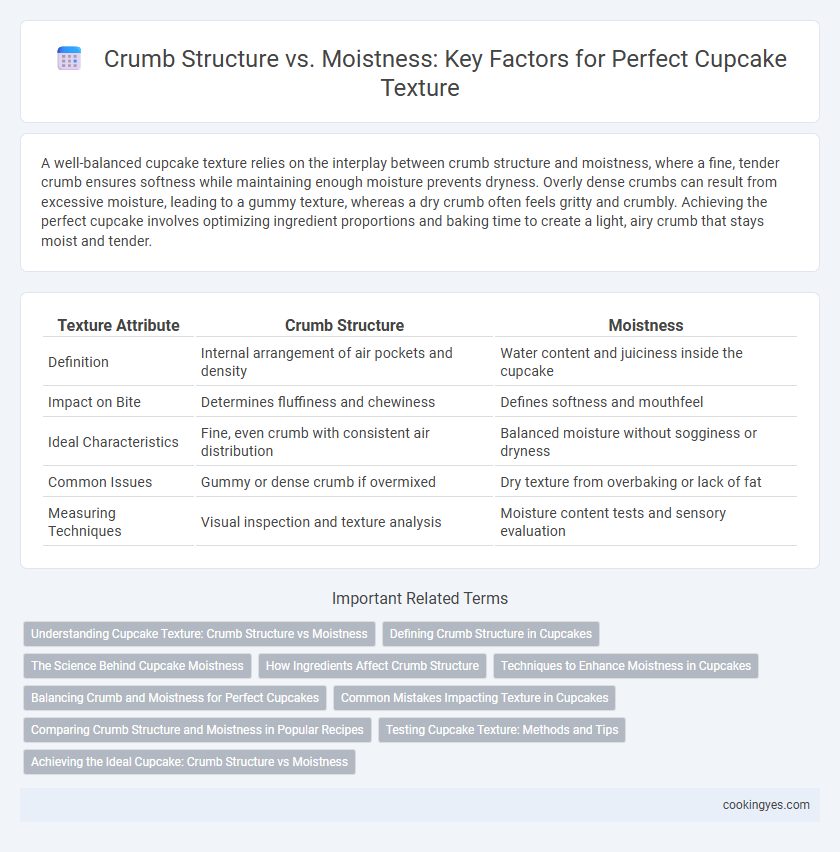A well-balanced cupcake texture relies on the interplay between crumb structure and moistness, where a fine, tender crumb ensures softness while maintaining enough moisture prevents dryness. Overly dense crumbs can result from excessive moisture, leading to a gummy texture, whereas a dry crumb often feels gritty and crumbly. Achieving the perfect cupcake involves optimizing ingredient proportions and baking time to create a light, airy crumb that stays moist and tender.
Table of Comparison
| Texture Attribute | Crumb Structure | Moistness |
|---|---|---|
| Definition | Internal arrangement of air pockets and density | Water content and juiciness inside the cupcake |
| Impact on Bite | Determines fluffiness and chewiness | Defines softness and mouthfeel |
| Ideal Characteristics | Fine, even crumb with consistent air distribution | Balanced moisture without sogginess or dryness |
| Common Issues | Gummy or dense crumb if overmixed | Dry texture from overbaking or lack of fat |
| Measuring Techniques | Visual inspection and texture analysis | Moisture content tests and sensory evaluation |
Understanding Cupcake Texture: Crumb Structure vs Moistness
Cupcake texture is defined by a balance between crumb structure and moistness, where a tender, fine crumb ensures a light and airy bite while adequate moistness prevents dryness without becoming soggy. The crumb forms through the interaction of flour proteins and leavening agents, creating small, uniform air pockets that contribute to softness. Moisture retention is influenced by ingredients like butter, oil, or sour cream, which lock in hydration, maintaining freshness and enhancing the overall eating experience.
Defining Crumb Structure in Cupcakes
Crumb structure in cupcakes refers to the internal texture characterized by the size, arrangement, and distribution of air pockets within the baked product. A fine, even crumb structure indicates uniform air incorporation, contributing to a tender and delicate mouthfeel while maintaining the cupcake's shape. Moistness interacts with crumb density by retaining hydration, which affects softness without compromising the cupcake's structural integrity.
The Science Behind Cupcake Moistness
Cupcake moistness is influenced by the balance of crumb structure, which is determined by the protein content in flour and the incorporation of fat and liquids during mixing. A fine, tender crumb with evenly distributed air pockets enhances moisture retention by reducing evaporation and creating a soft texture. Baking temperature and ingredient ratios also play crucial roles in maintaining the optimal moisture level while preserving the delicate crumb structure essential for a perfect cupcake texture.
How Ingredients Affect Crumb Structure
The crumb structure of a cupcake is primarily shaped by the balance of flour and fat, where higher protein flours create a denser crumb while fats like butter or oil contribute to tenderness and moisture retention. Sugar not only sweetens but also tenderizes the crumb by interfering with gluten formation, which affects overall texture and moistness. Egg proteins provide structure and stability, ensuring a fine, uniform crumb that supports a moist interior without becoming soggy.
Techniques to Enhance Moistness in Cupcakes
Crumb structure significantly influences cupcake texture, with a fine, tender crumb resulting in a softer bite while maintaining moisture. Techniques to enhance moistness include incorporating ingredients like sour cream or yogurt, which add acidity and fat, improving both crumb quality and moisture retention. Another effective method is underbaking slightly or brushing cupcakes with simple syrup post-baking to lock in moisture and extend freshness.
Balancing Crumb and Moistness for Perfect Cupcakes
Achieving the ideal cupcake texture requires a balanced crumb structure that is tender yet resilient, paired with optimal moistness to prevent dryness or sogginess. A fine, aerated crumb allows for even distribution of moisture, enhancing flavor and mouthfeel while maintaining structural integrity. Adjusting ingredient ratios, such as proper fat and liquid levels, ensures the cupcake remains soft and moist without collapsing or becoming dense.
Common Mistakes Impacting Texture in Cupcakes
Overmixing batter often leads to a dense crumb structure, reducing cupcake moisture and resulting in a dry texture. Underbaking is another mistake that causes excessive moisture, yielding a gummy crumb and poor rise. Proper mixing and accurate baking times are crucial for achieving the ideal balance between a tender crumb and moist interior in cupcakes.
Comparing Crumb Structure and Moistness in Popular Recipes
Crumb structure greatly influences the texture of cupcakes, with a fine, tender crumb often indicating a well-aerated batter, while moistness depends on the fat content and liquid balance in the recipe. Popular recipes like traditional vanilla cupcakes prioritize a light, fluffy crumb achieved through creaming butter and sugar, whereas recipes like chocolate or banana cupcakes tend to have denser crumbs paired with higher moisture from ingredients such as pudding or fruit puree. Balancing crumb structure and moistness is essential, as overly dense crumbs can feel heavy, while excessively moist cupcakes risk becoming gummy or collapsing.
Testing Cupcake Texture: Methods and Tips
Testing cupcake texture involves evaluating both crumb structure and moistness to achieve the ideal bite. A fine, uniform crumb indicates proper mixing and leavening, while a moist feel ensures freshness and proper ingredient balance, such as the right ratio of fat and liquid. Techniques like the toothpick test for doneness and gently pressing the surface can help bakers assess and adjust texture for perfect cupcakes.
Achieving the Ideal Cupcake: Crumb Structure vs Moistness
Achieving the ideal cupcake texture requires balancing crumb structure and moistness to create a tender yet sturdy bite. A fine, even crumb indicates proper aeration and ingredient dispersion, while adequate moisture ensures softness without sogginess. Optimizing flour type, fat content, and baking time directly influences this equilibrium, resulting in a cupcake that holds shape with a melt-in-the-mouth quality.
Crumb structure vs Moistness for cupcake texture Infographic

 cookingyes.com
cookingyes.com